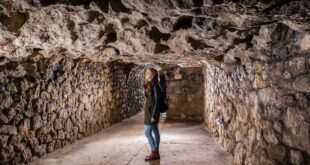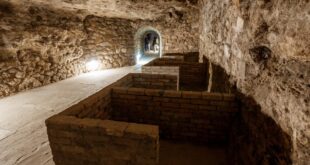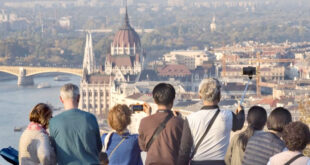Located near Matthias Church and Fisherman’s Bastion, the Holy Trinity Statue can be found in the middle of Holy Trinity Square. The column commemorates the people of Buda who died from two outbreaks of the Black Plague. These days, it is a popular meeting point for many walking tours in the Buda Castle District. Located in the heart of the Buda Castle District, directly in front of the Matthias Church, the Holy Trinity Statue is one of Budapest’s most significant baroque monuments. Erected in the early 18th century as an act of gratitude for the end of devastating plague epidemics, this richly decorated stone column has become a defining feature of Holy Trinity Square (Szentháromság tér).
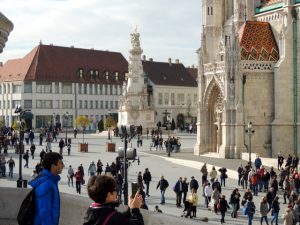
Whether you’re exploring Buda Castle’s historic streets, visiting Matthias Church, or joining a guided walking tour, the statue is impossible to miss—both for its size and symbolic power. Designed to protect the city from future epidemics, the monument reflects the religious devotion, artistic craftsmanship, and political symbolism of post-Ottoman Hungary. Today, it remains not only a popular tourist attraction and a practical meeting point for various tours, but also a vivid reminder of Buda’s transformation from a war-torn city to a centre of Habsburg-era culture and faith.
The Black Plague (causing the death of 30-60% of Europe’s total population) swept across Europe in 1691 and 1709, and many were buried in mass graves. Since people believed that erecting a column would keep away the plague, the foundation stone was laid in 1700.
In the late 17th century, Hungary was emerging from a century and a half of Ottoman occupation. Following the recapture of Buda by Habsburg forces in 1686, the city became part of the re-established Royal Hungary under the rule of the Austrian Habsburgs. By the 1690s and early 1700s, Buda’s population consisted largely of German-speaking settlers and Hungarian burghers rebuilding their homes and civic identity. Amid ongoing struggles with recurring plague epidemics, the town council of Buda resolved in 1694 to erect a Holy Trinity column in thanksgiving and as a spiritual safeguard against further outbreaks. This decision followed a broader European tradition, seen in similar plague monuments in Vienna (Pestsäule, 1693) and Munich (Mariensäule, 1638), reflecting the shared Catholic belief in divine intervention during times of crisis.
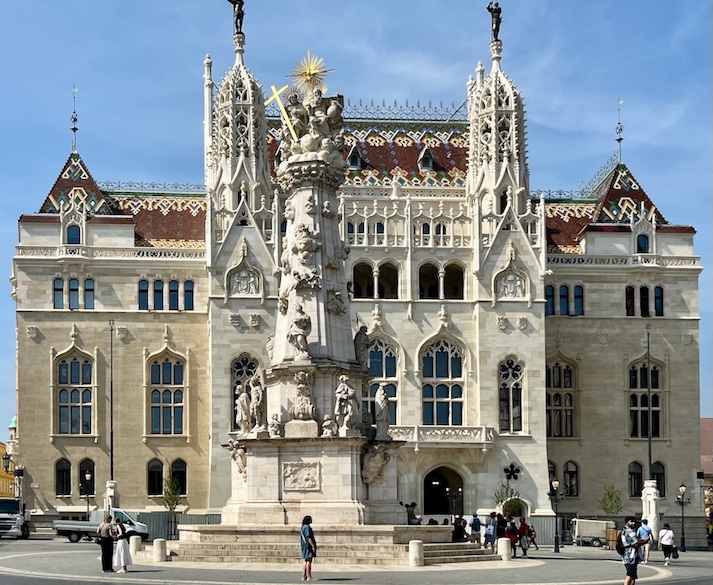
Even though, the first pillar was ready by 1706, three years later the plague returned to Budapest, and therefore a new, larger plague pillar was planned in order to keep the plague away at any costs. Residents believed the Holy Trinity Statue did its job, as the plague never returned after 1709.
History of Holy Trinity Statue
The first Holy Trinity statue was begun in 1700, designed by architect Ceresola Vereio and executed by master mason Bernát Ferretti. Completed in 1706, it was eventually relocated to Újlak (a suburb of Buda) in 1709 after another wave of plague, prompting the magistrate to commission an even grander replacement. The current monument, standing majestically in Holy Trinity Square next to Matthias Church, was sculpted by Fülöp Ungleich, with intricate coats of arms and reliefs carved by Antal Hörger. It was unveiled in 1713, standing as one of Central Europe’s finest Baroque plague columns, echoing the triumph of faith and the resilience of a recovering city.

At the pinnacle of the monument, the Holy Trinity is depicted in classical iconography: God the Father holds a sceptre symbolising divine authority, Christ the Son bears the Cross as a sign of redemption, and the Holy Spirit, represented as a dove, hovers above them. This composition reflects the Catholic understanding of one God in three persons, a mystery central to Christian theology.
Cherubic Heads – Heavenly Choir – Below the Trinity
Just below the Trinity, a ring of angelic cherub heads emerges from the clouds. These are not full angels, but their faces represent the eternal worshippers of God, often shown in baroque art as intermediaries between heaven and earth.
The Three Elevated Saints on Projections
On three outward-jutting cornices below the main group, we find statues of key intercessors:
- The Virgin Mary, Queen of Heaven, stands as the most powerful saint and maternal protector, often invoked during plagues. She is also patroness of Hungary, crowned by King St Stephen in the founding legend of the Christian Hungarian state.
- St John the Baptist, known for baptising Jesus and preparing the way of the Lord. He is often included in plague memorials for his role as a prophetic voice of repentance.
- St Francis Xavier, a Jesuit missionary who converted thousands in Asia. He is known for miraculous healings during epidemics, and his inclusion links to the growing Jesuit presence in Buda post-Ottoman era.
The Saints of the Cornice – Symbols of Healing and Virtue
- St Roch (Szt Rókus): Displaying his plague wound, Roch is the quintessential patron saint against epidemics, having tended plague victims in 14th-century Italy. His faithful dog, often shown bringing him bread, became a symbol of divine care in suffering.
- St John (probably the Evangelist): Holding a crucifix, this John (distinct from the Baptist above) is beloved as the disciple Jesus loved, often shown supporting Mary at the Crucifixion. He also authored the Book of Revelation.
- St Christopher: Shown carrying the Christ child across a river, Christopher is patron saint of travellers, and during the plague, he was believed to offer spiritual passage to safety.
- St Augustine: Depicted with a flaming heart, symbolising divine love and theological insight. A Doctor of the Church, his writings helped shape Christian understanding of sin, grace, and redemption.
- St Joseph: Holding a lily, emblem of purity and chaste fatherhood. As protector of the Holy Family, he became an ideal model for Hungarian Catholic fathers during times of uncertainty.
- St Sebastian: Pierced with arrows, Sebastian miraculously survived Roman execution. He became a plague saint when medieval Christians saw the arrows of disease in his suffering.
The Reliefs of the Holy Trinity Column – Visual Sermons in Stone
- David’s Prayer: King David is depicted repenting after calling a census that led to divine punishment (2 Samuel 24). His contrition and plea for mercy align with the city’s desire for divine forgiveness in the times of plague.
- The Plague in Buda: This visceral panel shows the agony of those struck by the pestilence – fallen bodies, grieving figures around the years of 1690s–1700s. It serves as both a historical record and a memento mori.
- The Founding of the Monument: The third relief shows the statue’s construction, linking faith with civic action. It is both a prayer and a promise, pledging remembrance.
The Coats of Arms – Power and Protection
Also on the bottom level of the Holy Trinity column you can see three coats of arms:
- The Habsburg Imperial Crest: Affirming the monument’s ties to the Holy Roman Empire and Habsburg rule post-1686.
- The Coat of Arms of Buda city: Reflects local governance and the city’s gratitude after surviving the Ottoman wars and plagues.
- The Hungarian Crest: Symbol of national identity and the re-Catholicisation process of the early 18th century.
A Monument at the Heart of Modern Buda Castle
Today, the Holy Trinity Column stands not only as a baroque masterpiece and a spiritual symbol, but also as one of the most iconic landmarks of the Buda Castle District. It serves as a common meeting point for numerous guided tours, including the popular Castle and Church Tour, the Daily Highlights Tour, and select underground cave explorations that begin from nearby locations.
The monument’s role in the urban landscape was further emphasised by the recent reconstruction of the former Ministry of Finance building, completed between 2020 and 2023 as part of Hungary’s ongoing Hauszmann Programme. With its renewed facades reflecting the historicist grandeur of the late 19th century, the ministry now forms a harmonious architectural ensemble with Matthias Church, the baroque statue, and the surviving medieval buildings that frame the square. This dialogue between eras—medieval, baroque, and neo-historicist—makes Holy Trinity Square one of the most visually and symbolically layered spaces in Budapest, offering visitors a profound experience where memory, beauty, and history converge.
Many of the Buda Castle Tours leave from this meeting point, at the Holy Trinity Statue.
Address of the Holy Trinity Statue
Szentháromság Square, Budapest, District I, 1014
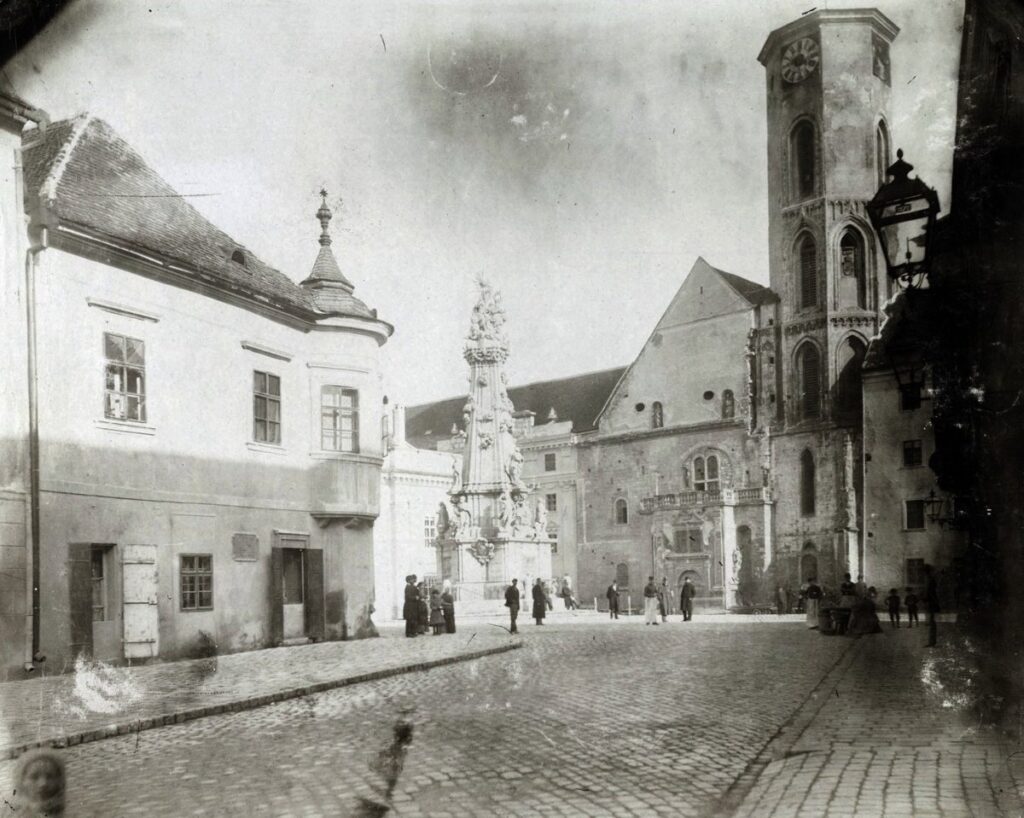
Did You Know? – Plague-Era Curiosities
- Plague doctors’ beaked masks held aromatic herbs like lavender or mint to counter “miasma,” thought to spread disease.
- “Plague stones” were used to disinfect coins in vinegar during transactions between infected and healthy parties.
- Loud noises were believed to drive away the plague—leading to bell-ringing, cannon fire, and processions filled with music and light.
 Buda Castle Buda Castle, Budapest
Buda Castle Buda Castle, Budapest




